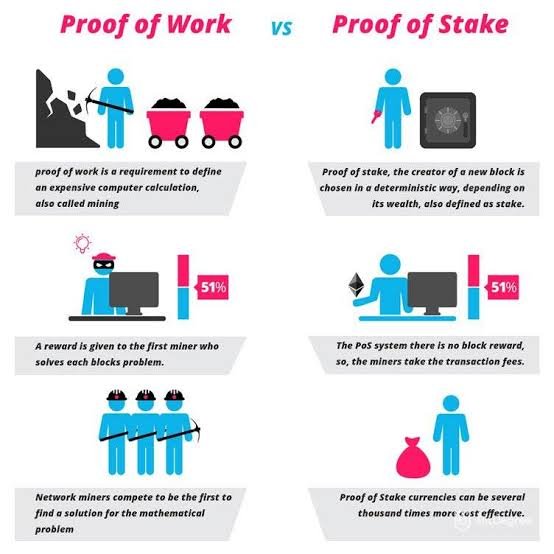PoS and POW - Steemit Crypto Academy Season 4 - Homework Post for Task 6

This post answer the question to the homework task for the steemit's Crypto academy fixed beginner's course task 6 by professor @sapwood, with the question;
What is the difference between PoW & PoS? Advantages & Disadvantages? Which one is better in scaling Capacity? Examples?

What is the difference between PoW & PoS?
%20(22).jpeg)
source
| PoW | PoS |
|---|---|
| PoW means proof of work and it is consensus mechanism that involves miner to decode some algorithm so that they can add verified transaction on the blockchain. | pos means Proof of stake and it is also a consensus mechanism but it involves a stalker or holder of the coin to become a validator for the minting of new block and verification of transaction |
| It requires hard work and time before work can be considered been done | it requires little or no work has validator only needs to be a holder of the token to become one. |
| This method pays miner with reward for every successful work done in form of new token | in PoS, the validator on receives the transaction fee without any other pay options |
| The proof of work is been made secured by the fact that no user will be willing to go through the stress and put in a lot of money just to receive a minite reward | proof of stake is been secured by the fact that no holder can have more that half of the total token of the blockchain |
| Payment of reward in new token help to increase the number of token in circulation | new token are not mined as validator take already made token as transaction fee |
| Heavy work requires high energy consumption, the same principle goes with the mining process as heavy work is done in it. | Energy consumption is very low as the process requires stake in the blockchain to become a validator. |
| PoW encourages Decentralisation as the process requires different user to work and the best gets the reward | decentralised of these process is minimal as the holder of the high percentage of token has an upper hand to even other person in the system. |
| In pow, their scale of work cannot be twerked as they are cannot go faster for confirmation of transaction | They are fast in verification of transaction and in term of scalability, they are better. |
| The hardware use for the mining process are quite expensive and the knowledge of the process are advance | validator only worries about the cost of holding token in PoS |

Advantages & Disadvantages?
Advantages of proof of work
It ensures maximum Decentralization of the blockchain network through it's form of verification of transaction on the network
It pays reward to the fastest and the First miner to process the verification of the transaction in new minted coin
It ensures anonymouscy of the blockchain network as it don't require the need for identification before verification of transaction.
After solving the algorithm and getting the work done, PoW offer the best consensus mechanism has it is quick to consensus on a valid block.
The miner of the blockchain can use their resources to mine more token for the blockchain network.
Disadvantages of proof of work
The know how of the work required in PoW is high as it is not easy to acquire the computer knowledge of solving the algorithm to get the work done
The reward received for the mining process increases the total supply of coin available whih in most cases might reduce the value of the coin
The miner hardware and tools are usually expensive which might not be affordable for some people will to join the process to be a miner.
The total energy consumption of the PoW process has some negative residual effect on the environment
Advantages of proof of stake
Validator requires token to become one and this token are asset on the blockchain not like the hardware of PoS that are additional expenses.
PoS does not make use of energy for the verification of transaction which makes it a better option for environmental protection
PoS do not require the excessive workdone orhigh technology knowhow before verification of transaction can take place
Verification of transaction are fast and time saving in PoS and their block are scalability during verification.
PoS offers security to the blockchain as it is almost impossible for any validator to own 51 percentage of the token on the network.

Disadvantages of proof of stake
The process requires staking of the asset you own over some fixed period of time and if need be for you to liquidate the asset, PoS makes that impossible
In some case, the cost of attack of the blockchain might be cost effective as the amount required to own 51 percentage of the total token is less to the gain the attacker will get on the completion of the hack.
Centralised power converge on the hand of the holder of the highest stalk has he own more chances of getting the validation power
The transaction fee of the transaction is the only reward receive by the validator and this reward is usually little to the one earned in pow

Which one is better in scaling Capacity? Examples?
Scaling capacity is the simply the ability of a service to be able to change or twerk is working size according to the amount of work load available for processing at a particular period of time. The capacity of a system to be able to change it range to comlete the work required of it is known as scalability.
PoW and PoS work fine but due to some of the requirement of these consensus mechanism the ability to scale is reduced. Considering this requirement I can say the PoS has a better scaling capacity because it is faster with a reduced cost and the time required by the system is not has much as that of the PoW.
PoS is capable of adjusting it's speed and time required to complete the verification thereby allowing it to complete more verification. Examples of PoS includes:
Cardona: this is the biggest blockchain on the proof of stake. Network for peer to peer transaction of their blockchain. The Ada token was created to be a beta version of the bitcoin and etherum network. It can complete up to 257 transaction per second
Etherum 2.0 : the second biggest blockchain of Cryptocurrency etherum is willing to be migrated from using the proof of work as a consensus mechanism to the proof of stake for the betterment of their blockchain. It can complete 15- 30 transaction when on the PoW but will complete about 100000 per second after the migration
Other examples of PoS include neo, algorand, Mina e.t.c

Conclusion
Both PoS and pow are good consensus mechanism of the blockchain network but in recent times, most blockchain tend to go for proof of stake has it is more efficient and has a lost of advantage over its PoW. This has got some blockchain to migrate form the use of proof of work to to the use of proof of stake, and a prefect example is the etherum network. There are more type of consensus mechanism but the proof of stake is still the more competitive with the pow used by the first Cryptocurrency, bitcoin.
%20(23).jpeg)
#club5050 😀